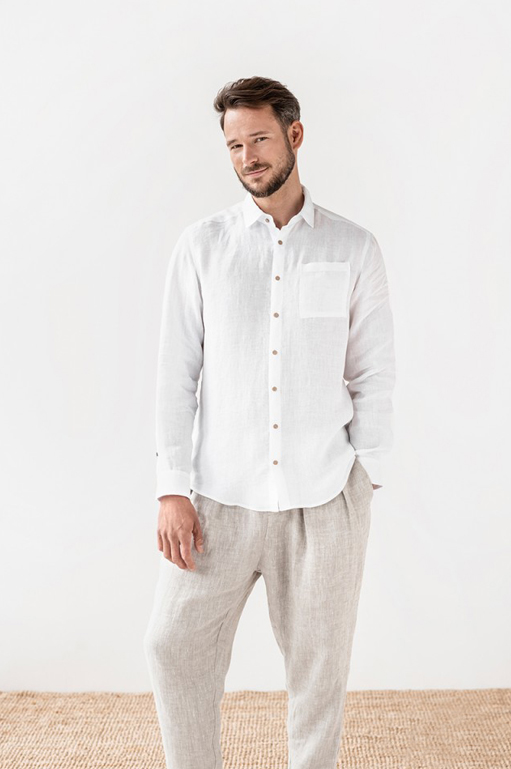Excellent Tips On Deciding On Bamboo Clothing
Wiki Article
Why Is Hemp Stronger, More Durable And More Biodegradable Than Cotton?
The inherent properties of hemp in addition to the way it's grown, make it more biodegradable, durable and sustainable than cotton. Here's why- Biodegradability-
Natural Fibers - Hemp, an organic fiber derived from plants is biodegradable. Fabrics and clothes made of hemp decompose in time. That means they return to nature without leaving any residue. Contrast this with synthetic fibers, like polyester which can take many years to break down.
Hemp textiles do not typically have chemical treatments or additives that can inhibit biodegradability. However, some cotton textiles are treated using synthetic chemicals such as dyes or finishes that can slow biodegradation process.
Durability-
Hemp fibres are known to be tough and durable. Fabrics and clothes made from hemp are less likely to get damaged, and last longer than some cotton products. This makes hemp garments can withstand many wash cycles and wear cycles before developing signs of deterioration.
Hemp fabric is less susceptible to pilling, which is the development of tiny, fuzzy balls at the surface of the fabric. This increases the life span of their fabrics and also the overall quality.
Regenerative Agriculture-
Soil Health Hemp cultivating is an effective regenerative process when done sustainably. Hemp cultivation that is sustainable has a deep-rooted system that will stop soil compaction. This root system assists in preventing erosion. This aspect of regenerative could leave the soil in better condition for future crops.
Low environmental impact Sustainable hemp cultivation techniques require the use of only a few pesticides. Contrary to conventional cotton farming, the use of synthetic chemicals can result in soil degradation and water pollution.
Water Efficiency-
Hemp grows with lower water requirements than cotton. Due to its drought-resistant characteristics, hemp can grow without much irrigation or rain. This makes it more water-efficient especially in areas where water resources are limited.
Crop Rotation Hemp is a good choice to incorporate into systems of crop rotation, which can improve the overall health of soils and decrease the possibility of soil loss and build-up of diseases. Cotton farming is not as susceptible to the effects of crop rotation.
Flexibility- Hemp can be used in a variety of applications, including clothes, textiles papers, paper, building materials and many more. Hemp is a versatile crop that can be used to aid a wide range of industries through environmentally sustainable and regenerative techniques.
It is important to know that hemp is an excellent product, but it can also be unsustainable, depending on the farming and processing methods. The benefits for the environment of hemp could be enhanced by choosing products that are made responsibly and in accordance with environmentally friendly practices. In the same way, choosing organic cotton products can mitigate some of the environmental concerns associated with conventional cotton production. Have a look at the top rated hemp clothes url for site advice including hemp wear, organic hemp underwear, hemp denim, patagonia hemp work pants, hemp apparel, hemp pants womens, hemp apparel, jungmaven clothing, patagonia iron forge jacket, 100 hemp t shirt and more.

How Do Hemp Fibers Improve Carbon Sequestration (Carbon Sequestration), Sustainability As Well As Crop Rotation (Crop Rotation)?
Carbon Sequestration Hemp fibers provide many benefits for the environment which include sustainability, crop rotation as well as carbon sequestration.
Rapid Growth- Hemp is a fast-growing plant that matures within 70-120 days, depending on the variety of plants and the growing conditions. Hemp plants absorb carbon dioxide (CO2) in their rapid growth stage as part of the photosynthesis process. This carbon uptake could aid in the sequestration of carbon dioxide, reducing levels of CO2 in the atmosphere.
Biomass Production- Hemp is renowned for its capacity to produce a lot of biomass. The tall stalks and the dense leaves of the plant yield an abundance of organic material. When incorporated in soil, or used for various purposes, could contribute to the accumulation of carbon.
Sustainability:
Hemp farming requires fewer synthetic pesticides. It also requires fewer herbicides. The natural resistance of hemp reduces the need for chemical interventions. Organic hemp farming, in particular, emphasizes sustainable agriculture by avoiding synthetic chemicals.
Water Efficiency- Hemp is a relatively water-efficient crop that can thrive with little irrigation, particularly when compared with more water-intensive crops such as conventional cotton. This is why it is more sustainable in areas that have limited water resources.
Hemp's deep-rooted system is able to improve the health of soil. Its roots deep can to reduce runoff by stabilizing the soil and enhancing soil structure. Hemp cultivation can also boost microbial action in the soil. This helps to improve the cycle of nutrient and soil fertility overall.
Hemp can easily be integrated in rotation systems. Crop Rotation is a process that involves rotating several crops over time within the same region. This method can help break the cycle of diseases and pests as well as reduce soil erosion and improve soil structure. Hemp's contribution to crop rotation is a key factor in the sustainability of farming practices.
Crop Rotation
Diversification- Hemp can be incorporated in crop rotation systems along with other crops, such as legumes grains, or even vegetables. This variety can help farmers maintain their soil health, lower the threat of pests specific to crop and diseases, and also promote balanced nutrient cycling.
The roots of hemp are deep and are able to penetrate soils and open them up which reduces compaction. It also increases water infiltration. A better soil structure can be a benefit to subsequent crops after hemp.
Summary Hemp fibers are beneficial to soil quality, are compatible with crop rotation, as well as enhancing the sequestration of carbon and sustainability. They do this through fast growth, biomass, low chemical usage, water efficiency and their ability to work with crop rotation methods. These characteristics make hemp cultivation an environmentally sustainable and regenerative agricultural practice, and the hemp fibers that result are an eco-friendly alternative for textiles as well as other applications. See the best hemp clothing for more tips including hemp t shirt mens, hemp textiles, patagonia hemp overalls, 100 hemp clothing, hemp fleece fabric, clothes made from hemp, hemp jeans mens, hemp swimsuit, hoodlamb coat, hemp shirts and more.

Bamboo Clothing Is Sustainable And Comfortable.
Bamboo clothing can be both comfortable and environmentally friendly.
The softness of bamboo is well-known for being exceptionally soft. It has a silky, smooth texture that feels soft against the skin. Bamboo clothing is luxuriously soft and popular for activewear, loungewear, intimate clothes, and many different kinds of clothes.
Breathability - Bamboo fibers are naturally breathable and moisture-wicking. The micro-gaps of the fabric permit air to circulate to keep you cool and cool in hot temperatures. The moisture-wicking properties help draw sweat away from your body, which reduces dampness.
Bamboo clothing has great thermoregulatory characteristics. It helps keep you warm when temperatures drop by retaining the heat near to your skin. In hot weather, it can keep you cool by allowing moisture and heat to escape. The ability to adapt to temperature fluctuations makes bamboo clothing ideal to wear throughout the year.
Hypoallergenic bamboo fabric is hypoallergenic, and gentle for sensitive skin. Bamboo fabric is less likely than other materials to trigger allergic reactions or irritations, making it a great option for those with sensitive skin or allergies.
Bamboo fibers naturally have antimicrobial properties, and can stop the development of bacteria that produce odor. Bamboo clothing is fresh, even while being physically active.
Environment-
Bamboo is a source of renewable energy that is ecologically sustainable. Bamboo is among the fastest growing plants on earth. It requires little water and doesn't require herbicides or pesticides in order for cultivation. Bamboo can be harvested with no damage to the plant since its roots regenerate.
Bamboo is a naturally water-efficient plant. It can thrive with minimal irrigation and can be planted using rainwater only which reduces the environmental impact that comes with the use of water in agriculture.
Biodegradability Bamboo clothing naturally decomposes when disposed of. This feature reduces the quantity in landfills of nonbiodegradable textiles.
Carbon Sequestration- Bamboos capture carbon dioxide (CO2) from the atmosphere during their fast expansion. Bamboo is a great choice as a carbon sink in order to help mitigate climate change.
Chemical Reduction- The manufacturing of bamboo fabric typically involves less chemical treatment and processing procedures compared to other textiles, thus reducing the environmental impact resulting from textile production.
Closed-Loop Systems Bamboo fabric production employs closed-loop processes which recycle chemicals and water. This minimizes waste and pollution.
It's important to note that the environmental impact of bamboo clothes can differ according to the particular manufacturing process employed and whether the bamboo utilized in the process is harvested from sustainable and ethically managed bamboo forests. For the best environmental results buyers should opt for bamboo clothing produced with eco-friendly and ethical methods. Read the recommended bamboo clothing hints for more examples including preemie bamboo pajamas, bamboo mens shirts, cozy earth clothes, bamboo clothing underwear, bamboo maternity, checkered bamboo pajamas, bamboo clothing, organic bamboo pajamas, bamboo chafing shorts, bamboo pants mens and more.
